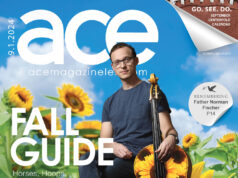Art In The Country
 Welcome to our 15th anniversary celebration of the Visual Arts in Lexington, beginning with this issue and the accompanying exhibit to be held this Sunday, July 18, 2004 at the Headley-Whitney Museum (part of our year-long ongoing 15th anniversary celebrations including concerts, readings, art, and more).
Welcome to our 15th anniversary celebration of the Visual Arts in Lexington, beginning with this issue and the accompanying exhibit to be held this Sunday, July 18, 2004 at the Headley-Whitney Museum (part of our year-long ongoing 15th anniversary celebrations including concerts, readings, art, and more).
As many longtime readers know, Ace started out, in 1989, as an Arts Quarterly magazine (publishing four issues annually, at the beginning). The work of local artists graced every black and white cover. Rodney Hatfield was the most prolific contributor,with too many covers to count to his credit. He ’s also chairing this Sunday ’s exhibit, which has been curated by Bill Hagan.
Over the course of 15 years, Ace has evolved, kicking and screaming,into a newsweekly —and Lexington ’s art scene has seen its own share of growing pains, achieving significant landmarks (e.g.,the growth of the Art League ’s annual Nude in the winter and Woodland Arts Fair in the summer, along with the LACC ’s prominent HorseMania and Dynamic Doors projects) juxtaposed against the obstacles of funding cuts, increasingly competitive market forces and recessions, and a political climate that often veered wildly from tepid to hostile when it came to embracing and supporting the arts.
Local organizations like the Art League and LACC have worked tirelessly to explain to fans and foes alike the socioeconomic and cultural value that the Arts delivers to a community, and their efforts seem to be catching on.
As for us, Ace has never been all things to all people when it comes to arts and entertainment (though over half of every book, every week, is devoted to A&E).
Ace has been very grateful to encounter some of the paper ’s very best friends within Lexington ’s arts community.
We ’d like to celebrate just a few of them with this week ’s issue and with Sunday night ’s exhibit. This is just a small sampling, and we only wish we had room to include more. But there ’s always next week, and the week after, and the week after … So stay tuned.
The odds are high that you ’ll meet artists along the way who ’ll enrich your lives and spaces the way they have ours.
Below is a brief introduction to the artists and their work.Following that is a sampling of the art they will be exhibiting Sunday evening.
ArtSnake is the name signed to Rodney Hatfield ’s artwork, delineating (somewhat) his art career from his longtime history as a musician (with the Metropolitan Blues All Stars, and varying other incarnations dating back to his days as a student at the University of Kentucky).
Hatfield, the honorary chair of this exhibit, contributed the covers of Ace ’s very first editions. He ’s a largely self-taught artist,who ’s been stylistically and thematically grouped with the outsider/primitive and folk-art movement. (Howard Finster ’s frequently cited for comparative purposes.) His work is known for its explosive use of color, primitive representations and stylistic touches with a thematic fascination focused on simple topics like death,family,religion and music. He creates images that vary from playful and whimsical to dark and southern gothic. His work is included in the collections of everyone from Liam Neeson to Gene Hackman.He returns this week from a national exhibit in Sante Fe, New Mexico,where he was described in the catalog as pouring out “a steady stream of magical fantastic creatures cavorting under moonlit,indigo skies; religious or mythical figures, inscrutable priests, shamans and sorcerers,and eerie self-portraits.The figures bristle,yearn, or simply echo that stunned feeling that affects the majority of the human race,appearing edgy, uncomfortable, and blisteringly alive.”
 Bruce Burris is a heavy hitter in the local art scene and is known just as well for his work as an advocate and activist (including his work at Latitude LLC and projects like Radical B.U.G.S.).
Bruce Burris is a heavy hitter in the local art scene and is known just as well for his work as an advocate and activist (including his work at Latitude LLC and projects like Radical B.U.G.S.).
In acknowledgement of his body of work as artist/activist/advocate, Burris made the Top Ten last fall in Ace ’s annual power issue.
His paintings themselves are narratives. They communicate stories and conversations heard in the work- place, on television and between friends. He feels that it is important for his work to portray this communication directly and honestly.
An oil painting he contributed to the cover of Ace ’s literary magazine, Voice, hangs in the newspaper ’s front office.
As for his participation in Sunday ’s exhibit, Burris comments,“Ace Weekly really has been an important part of the success of two programs that I helped to create which combine the arts and social service. Both Minds Wide Open art center and more recently Latitude have benefited from exposure early on in Ace …Ace ’s belief in what we were doing helped us out tremendously. Doing things a little differently in Lexington in the arts and social services means that you will not automatically get enthusiastic support; it ’s kind of a wait and see sort of place. This early period is a very vulnerable,exhausting time for a fledgling organization and sometimes a bit of cheerleading can help to get you over the hump.”
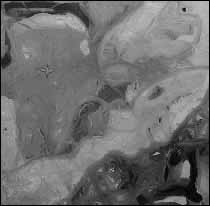 Charles Ellis began painting in 2000 and has proven to be as prolific as he is popular ever since —participating in dozens of exhibits,with his work featured in the homes and galleries of dozens of collectors, from New York to L.A.(where he has also exhibited).
Charles Ellis began painting in 2000 and has proven to be as prolific as he is popular ever since —participating in dozens of exhibits,with his work featured in the homes and galleries of dozens of collectors, from New York to L.A.(where he has also exhibited).
An abstractionist, Ellis says,“What I can ’t perceive is much more interesting than what I can visualize.I dive into a problem and paint the solution.”
Ellis has an extensive history with Ace in that the quarterly literary issue was the first appearance his art ever made in the local media —debuting a full color image of one of his paintings …
But Art is not the only contribution Ellis had made to one of Ace ’s silent auctions.
He himself was the inaugural Bachelor to be sold in Ace ’s first annual Bluegrass Bachelor Auction (now in its 5th year).
Though he ’s off the market now (in light of his upcoming nuptials),he reflects bashfully on the experience of being displayed before an audience of single women,“I tried to imagine them naked but that made matters worse.To be traded like a commodity on the open market was the thrill of my life. It ’s always good to laugh away the pain.”
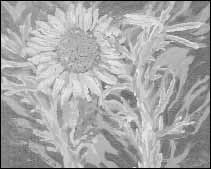 Nature plays a pivotal role in the work of Bill Glasscock, who holds an MFA from the Art Institute of Chicago and has also taught art locally in several capacities. One of his pieces graced the cover of Michael Kelsay ’s book, Too Close to Call .His work is frequently on exhibit (and available for purchase) at Alfalfa, where he’s a mainstay of the local art scene. He begins most of his landscapes with black ink and then adds color with colored pencils.He also has a strong interest in animation.
Nature plays a pivotal role in the work of Bill Glasscock, who holds an MFA from the Art Institute of Chicago and has also taught art locally in several capacities. One of his pieces graced the cover of Michael Kelsay ’s book, Too Close to Call .His work is frequently on exhibit (and available for purchase) at Alfalfa, where he’s a mainstay of the local art scene. He begins most of his landscapes with black ink and then adds color with colored pencils.He also has a strong interest in animation.
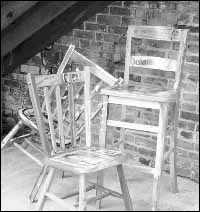 Pat Gerhard ’s work is recognized everywhere and by everyone around town —even by the few citizens who might not yet know her on a first-name basis (at last count,there were three).
Pat Gerhard ’s work is recognized everywhere and by everyone around town —even by the few citizens who might not yet know her on a first-name basis (at last count,there were three).
Lexington businesses use her fun and colorful style to dazzle-up signs and decorate streets.She is whimsical, fresh, and adds a spicy flavor to the local arts scene. On any given day, you might find her chalking a walk,tirelessly advocating the joys of downtown,or plying her creative wares at Limestone ’s longtime retail mainstay, Third Street Stuff, where she ’s proprietor, founder,artist,and entrepreneur.
She was voted as Ace ’s Best Artist in last year ’s “Best of Lex ”readers poll.
In describing her relationship with Ace, Pat comments,“If Lexington is going to go forward, if we want to grow jobs and build education,we have to have this kind of risk taking: people like [those at ] Ace who see the importance of young creative people finding Lexington a rewarding place to live and work —people who promote that there is a lot going on and we are talking about it!!!!”
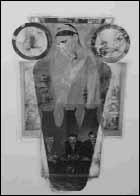 Local Artist Jack Girard is a professor at Transylvania University and recently presented his collage/mixed media at Vanderbilt University.He is considered socially, politically and interpersonally driven in his work, and strives to answer questions central to these discourses. Through a historic lens Girard comments on race, disability, aging, archeology and ordinance. His exhibit at Transy with Steve Armstrong was an Ace feature in the 90s —chronicling “A Side Show,”with a sly, carnival-esque theme.
Local Artist Jack Girard is a professor at Transylvania University and recently presented his collage/mixed media at Vanderbilt University.He is considered socially, politically and interpersonally driven in his work, and strives to answer questions central to these discourses. Through a historic lens Girard comments on race, disability, aging, archeology and ordinance. His exhibit at Transy with Steve Armstrong was an Ace feature in the 90s —chronicling “A Side Show,”with a sly, carnival-esque theme.
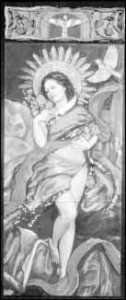 Diane Kahlo (yes,you recognize the famous last name) shares a studio with Miki Wright at Gallerie Soleil. She has a BA in painting and drawing,and in the past five years has shown in group and 2-person shows at Gallerie Soleil, Wingspan, ArtsPlace, Central Library gallery, Chapman Friedman (in Louisville),and Fraser Gallery (in Washington DC). Along with nine other Kentucky artists, she is currently participating in a traveling exhibit called “Thresholds,”a juried exhibit consisting of work from five southern states arts councils. Be sure to look for this show at Transy sometime next January. With a grant from the KY Foundation for Women, she is also working on a series of figurative paintings of Kentucky Women artists (visual,dancers, writers,actors).
Diane Kahlo (yes,you recognize the famous last name) shares a studio with Miki Wright at Gallerie Soleil. She has a BA in painting and drawing,and in the past five years has shown in group and 2-person shows at Gallerie Soleil, Wingspan, ArtsPlace, Central Library gallery, Chapman Friedman (in Louisville),and Fraser Gallery (in Washington DC). Along with nine other Kentucky artists, she is currently participating in a traveling exhibit called “Thresholds,”a juried exhibit consisting of work from five southern states arts councils. Be sure to look for this show at Transy sometime next January. With a grant from the KY Foundation for Women, she is also working on a series of figurative paintings of Kentucky Women artists (visual,dancers, writers,actors).
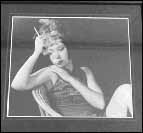 Steve May was raised in New York, educated in Mexico, matured in Chicago, worked in Kentucky, and now has retired at the Lexington Art League, where he teaches a popular class in figure drawing. May has contributed to each of the Art League ’s Nude exhibits and most recently participated in their Celebrations of Lifetime show. Recently, May has picked up a paint-brush, expanding beyond his world of photography. He is a Donavan Scholar who has concentrated his study in photography for the past 6 years. May insists “I take pictures because I like to do it,”and prefers the art itself over the pretense of changing the world.“I have been a photographer all my adult life. Doing portraits, magazines, sports,and commercial work. Since retiring I have had the opportunity to direct my work more towards the area of photography. This approach is much more enjoyable than shooting for clients.”
Steve May was raised in New York, educated in Mexico, matured in Chicago, worked in Kentucky, and now has retired at the Lexington Art League, where he teaches a popular class in figure drawing. May has contributed to each of the Art League ’s Nude exhibits and most recently participated in their Celebrations of Lifetime show. Recently, May has picked up a paint-brush, expanding beyond his world of photography. He is a Donavan Scholar who has concentrated his study in photography for the past 6 years. May insists “I take pictures because I like to do it,”and prefers the art itself over the pretense of changing the world.“I have been a photographer all my adult life. Doing portraits, magazines, sports,and commercial work. Since retiring I have had the opportunity to direct my work more towards the area of photography. This approach is much more enjoyable than shooting for clients.”
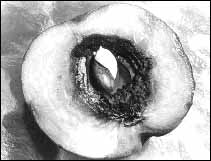 Guy Mendes is one of the most established photographers in the region (also well-known as a documentarian at KET) and is currently presenting at the Ann Tower Gallery.
Guy Mendes is one of the most established photographers in the region (also well-known as a documentarian at KET) and is currently presenting at the Ann Tower Gallery.
He has contributed much of his work to Ace over the years,and was last featured for his photographs of Alfalfa and its community.The University of Louisville, The University of Kentucky and the Cincinnati Art Museum all claim ownership of his prints. Mendes’s photographs have been displayed throughout the country at galleries including, the International Center for Photography in New York, the New Orleans Museum of Art, and the Boston Center for the Arts. His work is widely published and found also in many private collections. He is said to capture the unexpected in his photographs,and works to express,“the natural world and its blessings and mysteries.” His work ranges from landscape to portraiture, and has even won several Emmy Awards as a documentary writer,director and producer for Kentucky Educational Television.
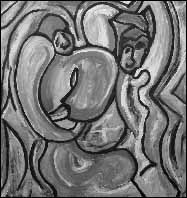 Paul Nowacki is an emerging artist in the community who was last featured in Ace —not for his art,but for his work as a chef (although one could argue that the two can certainly be related). However,his recent exhibitions have pushed him into the spotlight as one of Lexington ’s rising talents. His formal training at the Art Academy of Cincinnati ended when Nowacki decided to move beyond formal design and try something new. He strives to create not duplicate of reality but an entirely different reality in his work,breaking down images to achieve their basic form. Nowacki recently displayed his work in the opening of Intrinsic Gallery, and has also presented his charcoals and paintings in the Heritage Art Center and Gallerie Soleil.
Paul Nowacki is an emerging artist in the community who was last featured in Ace —not for his art,but for his work as a chef (although one could argue that the two can certainly be related). However,his recent exhibitions have pushed him into the spotlight as one of Lexington ’s rising talents. His formal training at the Art Academy of Cincinnati ended when Nowacki decided to move beyond formal design and try something new. He strives to create not duplicate of reality but an entirely different reality in his work,breaking down images to achieve their basic form. Nowacki recently displayed his work in the opening of Intrinsic Gallery, and has also presented his charcoals and paintings in the Heritage Art Center and Gallerie Soleil.
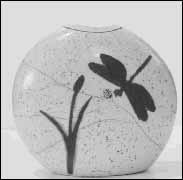 For the past 20 years, Wyman Rice ’s lauded work in ceramics has brought the artist numerous awards.Those from the region include a Purchase Award from the Woodland Art Fair, a Best of Show Award from the Kentucky Guild of Artists and Craftsmen ’s Spring Fair, and a First Place Award in ceramics from the Cherokee Art Fair in Louisville. His sculptures are handbuilt,using slab and coils, and fired in either raku of electric kilns. Choosing sculptural form over function, his pieces only suggest utility. They are defined by sharp lines and strong voluminous forms. He uses glazes and stains to characterize some pieces,while leaving others naked to emphasize their material.
For the past 20 years, Wyman Rice ’s lauded work in ceramics has brought the artist numerous awards.Those from the region include a Purchase Award from the Woodland Art Fair, a Best of Show Award from the Kentucky Guild of Artists and Craftsmen ’s Spring Fair, and a First Place Award in ceramics from the Cherokee Art Fair in Louisville. His sculptures are handbuilt,using slab and coils, and fired in either raku of electric kilns. Choosing sculptural form over function, his pieces only suggest utility. They are defined by sharp lines and strong voluminous forms. He uses glazes and stains to characterize some pieces,while leaving others naked to emphasize their material.
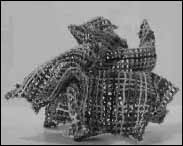 Born in New Mexico, Arturo Alonzo Sandoval joined the University of Kentucky in 1974,where he has since become internationally known. At UK, he began experimenting with mixed fiber as a medium, evolving beyond its traditional connotations as craft. He uses recycled materials from Mylar to microfilm, redefining textile art.Sandoval not only contributes to Lexington ’s artistic community through his work,he is also an active lecturer, curator, set designer, instructor, facilitator,board member and arts advisor. Both locally and nationally, Sandoval does it all. He can also boast that many of his students have gone on to have successful careers in the arts. Sandoval was recently awarded with the 2003 Governor ’s Award in the Arts for his lifetime of achievement.
Born in New Mexico, Arturo Alonzo Sandoval joined the University of Kentucky in 1974,where he has since become internationally known. At UK, he began experimenting with mixed fiber as a medium, evolving beyond its traditional connotations as craft. He uses recycled materials from Mylar to microfilm, redefining textile art.Sandoval not only contributes to Lexington ’s artistic community through his work,he is also an active lecturer, curator, set designer, instructor, facilitator,board member and arts advisor. Both locally and nationally, Sandoval does it all. He can also boast that many of his students have gone on to have successful careers in the arts. Sandoval was recently awarded with the 2003 Governor ’s Award in the Arts for his lifetime of achievement.
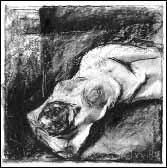 James Shambhu has exhibited sculpture and drawings at ArtsPlace, Gallery Soleil, and has been a regular exhibitor at the Nude shows at the Lexington Art Leagues Loudoun House. He is a Bachelor of Fine Arts graduate of the Sculpture program at UK under the watch of Jack Gron, Lynn Sweet and the late (extremely influential) John Tuska. His work is generally figurative in nature whether the medium is charcoal on paper, wood and steel, photographic, or paint. The work donated is charcoal and black pastel on watercolor paper. James Shambhu was Ace ’s first art director (following the work of graphic designer Aril Lowry) and designed the publication to its eventual evolution as a nationally recognized newsweekly. Village Voice Media ’s CEO and executive vice president characterized him as “the finest AAN art director in the country.” His enormously successful graphic design includes logos and ad work for businesses around Lexington including, Rossi ’s, IVOS, Medusa, ArtBeat Gallery (Louisville), Manny ’s Woodworkers Place, Paisley Peacock, and ILO.
James Shambhu has exhibited sculpture and drawings at ArtsPlace, Gallery Soleil, and has been a regular exhibitor at the Nude shows at the Lexington Art Leagues Loudoun House. He is a Bachelor of Fine Arts graduate of the Sculpture program at UK under the watch of Jack Gron, Lynn Sweet and the late (extremely influential) John Tuska. His work is generally figurative in nature whether the medium is charcoal on paper, wood and steel, photographic, or paint. The work donated is charcoal and black pastel on watercolor paper. James Shambhu was Ace ’s first art director (following the work of graphic designer Aril Lowry) and designed the publication to its eventual evolution as a nationally recognized newsweekly. Village Voice Media ’s CEO and executive vice president characterized him as “the finest AAN art director in the country.” His enormously successful graphic design includes logos and ad work for businesses around Lexington including, Rossi ’s, IVOS, Medusa, ArtBeat Gallery (Louisville), Manny ’s Woodworkers Place, Paisley Peacock, and ILO.
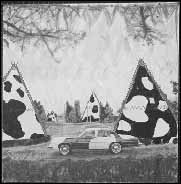 A longtime photographer for Ace, Aimee Tomasek contributed much of her work during the 1990s,before relocating out west to pursue her art career in a different setting.
A longtime photographer for Ace, Aimee Tomasek contributed much of her work during the 1990s,before relocating out west to pursue her art career in a different setting.
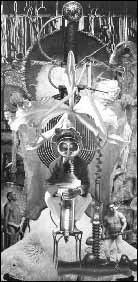 Best known for Wingspan Gallery, Carleton Wing also gained prominent local acclaim for designing the prototype horse that kicked off the LACC ’s “Horse Mania,”which was featured in Ace. His collages deal mostly with gender related social issues and he acknowledges the masculine or feminine qualities in images and objects. He removes images from popular magazines and recreates them in a surreal context establishing an entirely different message.
Best known for Wingspan Gallery, Carleton Wing also gained prominent local acclaim for designing the prototype horse that kicked off the LACC ’s “Horse Mania,”which was featured in Ace. His collages deal mostly with gender related social issues and he acknowledges the masculine or feminine qualities in images and objects. He removes images from popular magazines and recreates them in a surreal context establishing an entirely different message.




